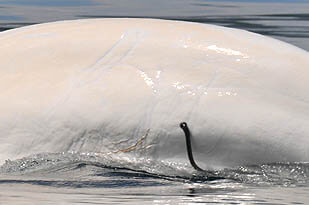Barnacles
In the St. Lawrence, humpback whales are known to have the most number of barnacles. Barnacles are crustaceans that attach themselves to a substrate—a boat, a dock, a rock or a whale—in their last developmental stage as free-floating larvae. Once they find their substrate, they attach themselves head first using a strong brown adhesive. Soon after, they secrete limestone-like materials that create their protective housing, helping the barnacles remain on the substrate. Oftentimes, this substrate ends up being a slow-moving whale, such as a right whale. When the whale swims through the waters, the barnacles filter-feed on plankton using six pairs of feathery appendages. Whale barnacles tend to be species-specific, meaning: barnacles on humpbacks from a particular subpopulation tend to be the same kind. Like diatoms, there are barnacle species endemic to colder, warmer, and temperate waters.
Whale lice
ther small crustaceans are found by the thousands in those parts of the whales’ bodies protected from water turbulence such as the eyes, lips, genital slits, ventral grooves, etc. Given their appearance and their size with respect to that of their hosts, whalers called them whale lice. They measure 6 to 19 mm and have a flattened body with four pairs of claw-like legs. They feed on the skin of the whales. Incapable of swimming or surviving in the open water, they travel from one whale to another by direct contact. Like barnacles, whale lice, also called cyamids, most often attach themselves to slower-moving whales. Generally, each “whale louse” is associated with a particular species of whale. In sperm whales, there is even sex-specificity. In North Atlantic right whales, three species of whale lice can be found depending on the age and the health of the individuals.
Lamprey
Lamprey are carnivorous fish which attach themselves using their suction cup-like mouth to other fish and even whales. Using their small cutting teeth, they chew into the skin of their host to feed on their blood as well as other body fluids. Although these primitive fish cause serious damage to native fish stocks of the Great Lakes, they do not seem to inflict significant injury to whales.




